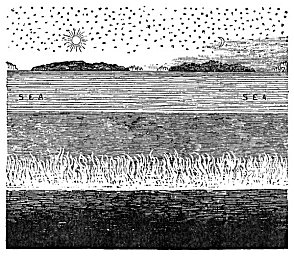
Sacred Texts Earth Mysteries
Buy this Book at Amazon.com


Flat Earth (Public Domain Image) |
Zetetic AstronomyEarth Not a Globeby Parallax (Samuel Birley Rowbotham)[1881] |
Samuel Birley Rowbotham, under the pseudonym 'Parallax', lectured for two decades up and down Britain promoting his unique flat earth theory. This book, in which he lays out his world system, went through three editions, starting with a 16 page pamphlet published in 1849 and a second edition of 221 pages published in 1865. The third edition of 1881 (which had inflated to 430 pages) was used as the basis of this etext.
Rowbotham was an accomplished debater who reputedly steamrollered all opponents, and his followers, who included many well-educated people, were equally tenacious. One of them, John Hampden, got involved in a bet with the famous naturalist Alfred Russel Wallace about the flat earth. An experiment which Hampden proposed didn't resolve the issue, and the two ended up in court in 1876. The judge ruled against Hampton, who started a long campaign of legal harassment of Wallace. Rowbotham hints at the incident in this book.
Rowbotham believed that the earth is flat. The contients float on an infinite ocean which somehow has a layer of fire underneath it. The lands we know are surrounded by an infinite wilderness of ice and snow, beyond the Antarctic ocean, bordered by an immense circular ice-cliff. What we call the North Pole is in the center of the earth.
The polar projection of the flat earth creates obvious discrepancies with known geography, particularly the farther south you go. Figure 54 inadvertantly illustrates this problem. The Zetetic map has a severly squashed South America and Africa, and Australia and New Zealand in the middle of the Pacific. I think that by the 19th century people would have noticed if Australia and Africa were thousands of miles further apart than expected, let alone if Africa was wider than it was long!
The Zetetic Sun, moon, planets and stars are all only a few hundred miles above the surface of the earth. The sun orbits the north pole once a day at a constant altitude. The moon is both self-illuminated and semi-transparent. Eclipses can be explained by some unknown object occulting the sun or moon. Zetetic cosmology is 'faith-based', based, that is, on a literal interpretation of selected Biblical quotes. Hell is exactly as advertised, directly below us. Heaven is not a state of mind, it is a real place, somewhere above us. He uses Ussherian Biblical chronology to mock the concept that stars could be millions of light years away. He attacks the concept of a plurality of worlds because no other world than this one is mentioned in the Bible.
Rowbotham never adequately explains his alternative astronomy. If the Copernican theory so adequately explains planetary motions, why discard it, and what would he use in its place? What is the sun orbiting around once a day and how does it work like a spotlight, not a 'point source'? If the moon is self-luminous, what creates its phases? If gravity appears to work here on earth, why doesn't it apply to the celestial objects just a few hundred miles up?
To make his system work he had to throw out a great deal of science, including the scientific method itself, using instead what he calls a 'Zetetic' method. As far as I can see this is simply a license to employ circular reasoning (e.g., the earth is flat, hence we can see distant lighthouses, hence the earth is flat).
Zetetic Astronomy is a key work of flat-earth thought, just as Donnelly's Atlantis, the Antediluvian World is still considered required reading on the subject of Atlantis. If you ever have to debate the flat earth pro or con, this book is a complete agenda of each point that you'll have to argue.
--John Bruno Hare, June 16th, 2005.
Chapter III. The Earth No Axial or Orbital Motion
Chapter XV. General Summary--Application--Cui Bono